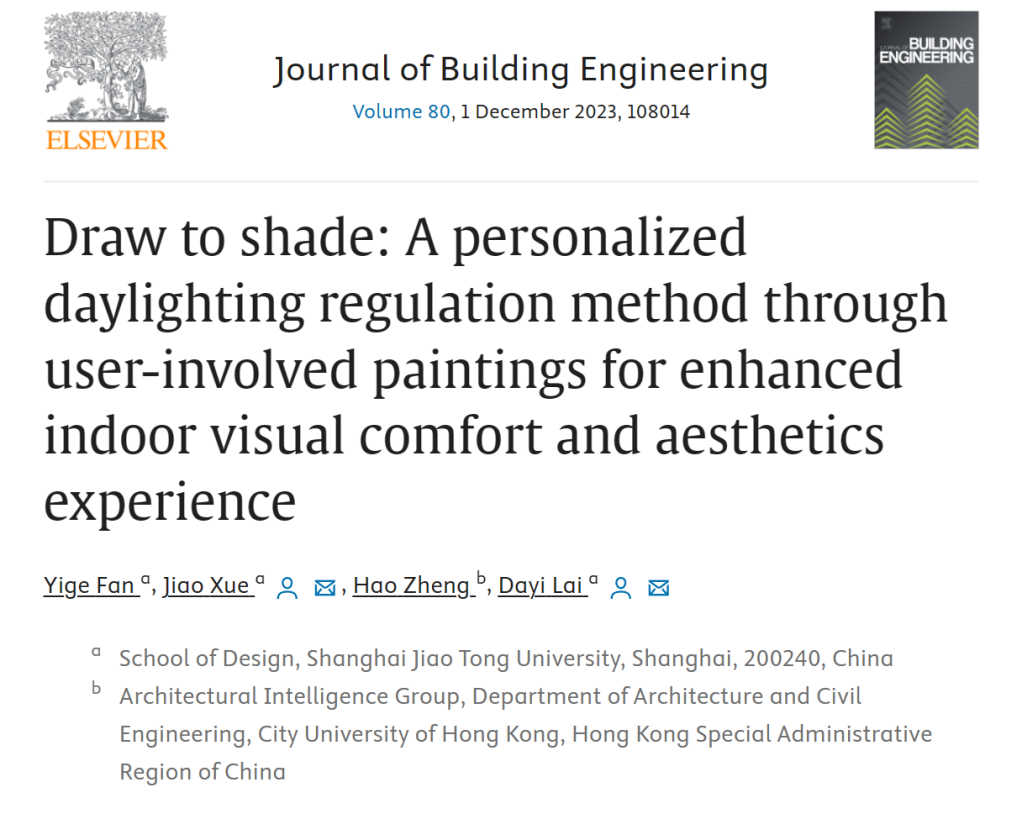学术快讯 | 用户参与式设计创新-视觉舒适与审美体验的个性化提升
近日,上海交通大学设计学院国际工业设计工程专业(IIDE)硕士研究生范佚阁以第一作者身份,在高水平国际期刊《Journal of Building Engineering》(影响因子IF=6.4,JCR Q1)上发表了学术论文“Draw to shade: A personalized daylighting regulation method through user-involved paintings for enhanced indoor visual comfort and aesthetics experience”。该研究提出一种用户参与式产品设计方法,结合多目标日光性能模拟优化和人工智能绘画创作平台来实现室内自然光调节,设计并制作了可调节的流体纤维原型作为实践案例演示方法的应用场景。

论文摘要
自然采光对身心健康的影响至关重要,然而,由于已建成建筑的构造、外观和功能属性的差异,以及不同居住者的审美偏好差异,遮阳设计研究未能为提高视觉舒适度和居住者审美体验提供可调节的个性化方案。本研究以“draw to shade”的概念为灵感,结合多目标日光性能模拟优化和人工智能绘画创作平台,提出一种用户参与的设计方法:通过不透明和透明的色块生成绘画来调节室内采光。结果表明,该方法降低了日光眩光概率(DGP),效率表现为8.30%-64.2%,同时将每小时有用日光照度(hUDI)控制在可接受的范围内。此外,本研究还演示了一种基于流体纤维概念的制造原型,以探索该方法的应用空间。总的来说,该研究可以启发更多关于日光调节的研究,同时兼顾性能、美学和应用,使人们在不同的空间中以个人的审美意愿提高视觉舒适度。
Abstract
The natural lighting plays a pivotal role in people's physical and mental well-being when people stay indoors for a long time. However, due to construction, appearance and attributes differences of built buildings, and various occupants' aesthetic preference, shading design fail to provide adaptive personalized scheme for visual comfort improvement and occupant aesthetics experience. Inspired by the concept of “draw to shade”, this study proposes a user-involved method to generate paintings with opaque and transparent blocks to regulate daylighting indoors by combining multi-objective daylight simulation and occupant-interactive AI creation platform. As a result, the method reduces the daylight glare probability (DGP) with an efficiency of 8.30%–64.2%, while controlling hourly Useful Daylight Illuminance (hUDI) within an acceptable range. We also demonstrate a fabrication via concept of fluid fibers to explore the application space of the method. Overall, the study can inspire more research on daylight regulation, while taking into account performance, aesthetics and application, to enable people improve visual comfort at individual aesthetic will in different spaces.
-1701339169076.png)
“Draw to Shade”方法的工作流程
The workflow of “Draw to Shade” method
-1701339176826.png)
多目标日光性能模拟优化和人工智能绘画创作平台的结合
The combination of multi-objective daylight simulation and AI painting creation platform
-1701339187261.png)
使用“Draw to Shade”方法调节采光后的眩光指标比较
DGP Comparison before and after using the "Draw to Shade" method
-1701339202537.png)
可调节流体纤维原型的概念设计:一种可编程的交互界面
Conceptual design of fluid fiber prototype: a programmable interactive interface
-1701339210924.png)
可调节流体纤维原型的实践应用
Practical application of fluid fiber prototype
作者简介
范佚阁,上海交通大学设计学院国际工业设计工程专业研究生。以设计思维,以人为本的设计为研究策略,结合用户体验,人机交互和参数化设计研究方法,探索可交互材料和装置在响应式环境,人居光、热舒适性领域的应用价值。硕士在读期间已发表学术论文4篇,国家专利1项,国家级、省部级竞赛获奖近20项,获评国家奖学金,三好学生标兵等。
Yige Fan is pursuing her master's degree in International Industrial Design Engineering, at the School of Design, Shanghai Jiao Tong University. With design thinking and human-centered design as research strategies, combined with user experience, human-computer interaction, and parametric design research methods, she aspires to the application value of interactive materials, tangibles, and systems in the field of responsive environment, human visual, and thermal comfort. During her postgraduate study, she has published 4 papers and 1 patent, been awarded by nearly 20 national and provincial design competitions, and won the national scholarship and merit student.
该论文合作作者为香港城市大学建筑及土木工程学系建筑智能组助理教授郑豪。通讯作者为上海交通大学设计学院设计系助理教授薛娇,上海交通大学设计学院建筑学系副教授赖达祎。
The paper is co-authored by Hao Cheng, Assistant Professor in the Architectural Intelligence Group, Department of Architecture and Civil Engineering, City University of Hong Kong. Corresponding authors are Jiao Xue, Assistant Professor, Department of Design, School of Design, Shanghai Jiao Tong University, and Dayi Lai, Associate Professor, Department of Architecture, School of Design, Shanghai Jiao Tong University.
论文全文阅读链接:
https://authors.elsevier.com/c/1i10t8MyS96aTq
Read the full paper: :
https://authors.elsevier.com/c/1i10t8MyS96aTq